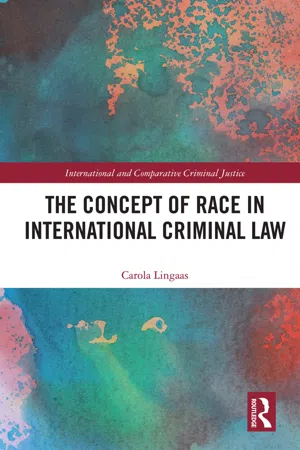Whenever we describe someone or name something, we impose a classification. Classification is a fundamental operation of the human mind and therefore a product of our capacity for abstraction. The problem lies not in our ability to classify, but in treating classifications as though they were real.2 The construction of a racial identity is essentially the outcome of a number of collective experiences involving the creation of binary pairs or opposites.3 Each epoch, each society, each nation creates and re-creates ‘others’. The identification and classification of these ‘others’ are subject to continuous interpretation and reinterpretation of how they differ from ‘us’. Their identity in this sense can therefore be wholly artificial, created solely with a view to highlighting perceived differences between ‘us’ and ‘them’ – and to justify discriminatory treatment.4 The crimes of genocide, apartheid, and persecution originate at this group-level discrimination of ‘others’.
In international criminal law, the provisions on the crimes of genocide, apartheid, and persecution all include references to the concept of race. In each instance, the law seeks to protect individuals recognised as belonging to a group or collectivity.5 The perpetrator6 targets an individual precisely because of his7 membership of such a group, including the racial group. Race is thus one of several categories that the law puts at the disposal of the courts. For the crime of genocide, the law offers the racial, ethnical, religious, and national group. For the crime of apartheid, the law only mentions the racial group, while the crime of persecution lists political, racial, national, ethnic, cultural, religious, gender, or other grounds that are universally recognised as impermissible under international law.8 The category ‘racial group’ is an analytical tool for extrapolating from individual victims the purported characteristic of the imagined archetypal ‘racial’ group member.9 However, the assignment of victims to such a category does not signify its objective existence. What it does show is that the perpetrators – and consequently the judges – assume that they do.10
The concept of race has a physical connotation, originating in the now highly contested idea of classifying individuals according to one or more phenotypical traits. At the same time, race transcends biology and carries with it a metaphysical dimension, according to which a person’s racial group membership is defined by a perception of his otherness. Despite scientific advances in genetic research overturning common beliefs of the existence of racial categories of humans, the social relevance of racial categorisation, racial discrimination, and race-thinking remains high.11 Race-thinking is a way of imagining the distinctiveness of human groups and assigning meaning to perceivable features of the human body.12 As such, the contours of race are inextricably linked to a mental image. So even though humans cannot be exhaustively divided into discrete biological human races, individuals are nonetheless targeted for their imagined membership of an imagined racial group. For the crimes of genocide, apartheid, and persecution, the victims’ racial group membership is inherently linked to processes of discrimination, stigmatisation, inferiorisation, and what is generally known today as ‘othering’. The perpetrators of these crimes interpret race as signifying their own superiority in the face of the inferiority of their victims, an idealized conception, which, in the mind of the perpetrators justifies an assault on the inferior racial group. The latter group is considered intrinsically different and alien and triggers feelings of fear. The perpetrator perceives the inferior group as a threat to the dominant group’s position, resulting in prejudices as a defensive action.13
Much of our (legal) worldview depends on an understanding of objectivity.14 In their search for an objective reality, courts seek to render predictable, verifiable judgments that are coherent with the principle of legality and its corollaries of specificity and foreseeability.15 The Commission of Experts on Rwanda, for example, stated that while there is a need ‘to recognise that there exists discrimination on racial or ethnic grounds, it is not necessary to presume or posit the existence of race or ethnicity itself as a scientifically objective fact’.16 There is no legal requirement to advance or claim an objective classification of the racial group for any of the crimes examined in the framework of this study. Rather than relying on the objectivity of criminal law, courts need to see through the eyes of the perpetrator. This study therefore suggests a subjective definition of the racial group, one mirrored in the perpetrator’s intent and perception of his victims’ otherness.
